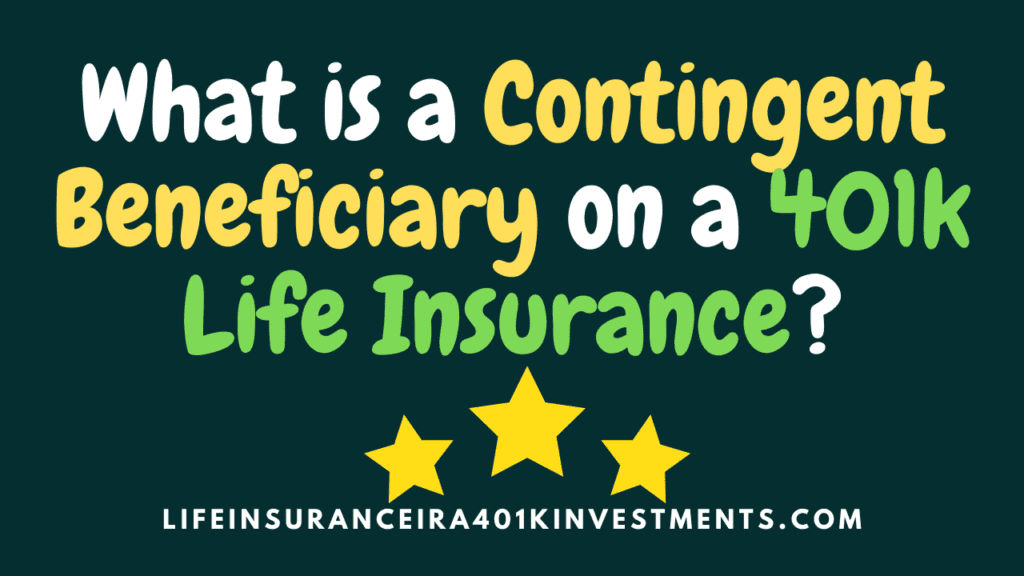What is a Contingent Beneficiary on a 401k Life Insurance?
Whether it’s a life insurance policy, bank account, securities account, retirement account, trust or other asset. Allocating contingent beneficiaries can avoid legalization and help achieve your planning goals patrimonial.

Do I have to name a contingent beneficiary? As an individual you do not have to specify a contingent beneficiary on a 401k life insurance. However, namely primary and contingent beneficiaries will help ensure that your assets are passed on to individuals / entities.
Contingent Beneficiary
You can also designate contingent beneficiaries in your will. This will not prevent legalization.
But it can be used to achieve your estate planning goals about 401k life insurance benefits.
Basic Terminology of the Beneficiary
Beneficiary. An entity of person (such as a charity) designated in your will to receive an asset after your death.
Remaining contingent beneficiary. The beneficiary of a remaining contingent interest.

Remaining interest contingent. A beneficiary’s interest in the property. The beneficiary will acquire the property in the future. In the event of a certain event or “contingency” (such as the death of the current owner).
What is a Primary Beneficiary Versus a Contingent Beneficiary?
When your will designates a primary or contingent beneficiary, that person or entity is a beneficiary of your will. The Property delivered to the beneficiary still has to go through a succession. But will go to the beneficiary instead of being part of his general property and being shared among his other heirs.
Many types of assets also allow you to designate a beneficiary who will receive the asset when you die. Along with them include 401k life insurance policies, bank accounts, IRA and 401 (k) accounts.
Brokerage Accounts, College Savings Plans, Health Savings Accounts, and Trusts. In some states, a beneficiary can also be designated for automobiles and real estate. A primary beneficiary is someone you designate to receive an asset after your death
Life Insurance Benefits
A primary beneficiary is a person you designate to receive an asset after your death.
Contingent beneficiary is a person or entity (such as a charity) that you allot to receive an asset. Upon your death if the primary beneficiary died before you.
A contingent payee can also come into play if the primary payee. can’t be located or refuses to accept the asset.
A primary beneficiary for one asset may be designated as a contingent beneficiary for a different asset. However, it would not make sense to designate someone as the primary and contingent beneficiary for the same asset.
What if There is No Contingent Beneficiary?
The primary beneficiary is dead, the asset cannot be found or rejected, and there is no conditional beneficiary. Then the asset ends up in your general property and has to go through a succession.
You have a will, the asset will go to those designated in the will. Also you do not have a will, the asset will go to your heirs as required by your state’s inheritance laws.

Can a Child be a Contingent Beneficiary?
A child can be a primary or a conditional beneficiary. It is very common to list a spouse as the primary beneficiary and children as the conditional beneficiary.
However, if the child is a minor, a guardian must be hired to manage the asset. At least until the child reaches the age of majority. You can also extend the tutor’s administration at a later age, for example.
Till your child graduates from college or until another event occurs that you specify.
Contingent Beneficiaries Under Will
The discussion above relates to where the “contingent liability” under which the contingent beneficiary receives ownership. It is the death or unavailability of a primary beneficiary.
Under a will, there are other contingencies that may come into play. Other contingent liabilities typically include reaching a certain age or the occurrence of a future event such as graduation from college.
Difference Between Contingent and Primary Beneficiaries
A conditional beneficiary is someone or something who receives the benefits of an account when the primary beneficiary.
May not or will not do so after the Account Owner’s death. Conditional beneficiaries are in line to inherit assets when things go wrong. Think of this as a backup 401k life insurance.
Conditional beneficiaries can only inherit if the main beneficiary does not. The Account Manager will pass the asset in question on to your Conditional Beneficiary if your Primary Beneficiary cannot be found. Rejects the inheritance, is not legally capable of accepting it, or previously dies.
Primary Beneficiaries
When you invest in a financial account named by the beneficiary, such as an individual retirement account (IRA), a 401 (k). Also an insurance policy, you need to name the people or institutions you want to keep the assets in the account when you die.
You can designate more than one main beneficiary and more than one conditional beneficiary. This is not limited to one at a time. As an individual it can assign percentages for each beneficiary, specifying how much of the account they should receive or inherit.
For example, you can name your spouse as the primary beneficiary of 100% of the account. And your two adult children as contingent beneficiaries to receive 50% each. You can also name your spouse as the primary beneficiary for 50% of the account. With your children named as primary beneficiaries for 25%.
You can even designate a nonprofit as a primary or conditional beneficiary. Although you probably want to speak to a account manager or tax advisor about how to do it. The point is, you can cut it the way you choose.
Restrictions on Beneficiaries
Please note that individuals you name as contingent beneficiaries must also be legally capable of taking possession. Of the asset in question in the event of death. Otherwise it undoes the whole purpose.
Naming your underage children can also cause problems as they will not be able to accept the gift. Up to the age of 18 or 21, according to state law.
A legal guardian must be appointed to accept the money on behalf of a minor. And administer it until she is the majority age. It is possible to appoint a legal guardian for minors who are considered beneficiaries.
So every gift before the account holder dies. However, if a guardian has not yet been appointed, the courts must appoint one, and this is time consuming and can be expensive.
Changing Beneficiaries
Contingent beneficiaries and primary beneficiaries can be changed easily. Unless the account is irrevocable (some insurance policies and trusts are) .
But if you want to change beneficiaries into an IRA or 401(k) account. You can do it quickly and easily: sometimes even online. Usually it’s just a matter of completing a form.
For an IRA, contact your plan’s custodian to make the necessary changes. Contact your plan administrator if you want to make changes to a 401(k) plan or other employer-sponsored retirement plan.
Keep your Beneficiaries up to Date
It is important to keep your beneficiaries updated at all times. They must know that they are beneficiaries. Whether they are primary or contingent, and they must have the details of what they inherit. It is often up to them to make claims for the assets in question when the time comes.
You may want to revisit your beneficiary choices periodically. To make sure they still fit into your current stage of life. The need to update your beneficiary 401k Life Insurance information generally occurs after major life changes.
Such as a marriage, birth, divorce, or death in the family. Another reason to update beneficiary information is that you may have simply changed your mind. About how you want to strategically transfer wealth to other family members.
What is a Contingent Beneficiary on a 401k Life Insurance?
Other considerations
Notifying its beneficiaries. If a beneficiary is primary or contingent, you must inform the beneficiary of your status. They will need to know this, so they can take the necessary steps to receive the asset after your death.
Multiple beneficiaries. You can designate multiple primary or contingent beneficiaries for the same asset. This would imply designating the percentage of the asset to go to each co-beneficiary.
Change or add beneficiaries. In general, you can change or add primary or contingent beneficiaries at any time. However, there may be restrictions with certain assets. (such as irrevocable retirement plans and accounts, 401k Life Insurance policies, or trusts).
In the context of an cheap life insurance policy, the condition is generally the death. Of the holder of the insurance contract; The part that benefits is called the primary beneficiary.